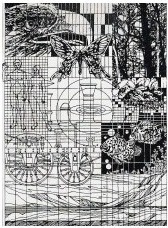
An Electronic Newsletter
of EEA's Environmental Consulting Activities
Summer 2003
EEA, Inc.
55 Hilton Avenue
Garden City, New York
(516) 746-4400
(212) 227-3200
(800) 459-5533
additional New York offices:
Stony Brook
(631) 751-4600
Altamont
(518) 861-8586
New Jersey Office:
Weehawken
(201) 865-8444
e-mail addresses:
General:
mailto:eea@eeaconsultants.com
Individual:
First initial and last name
@eeaconsultants.com
EEA services include
Phase I ESAs, Haz-Mat
Testing and Remediation, Wetlands
Delineation
and Creation, Natural
Resources Inventories,
Marine Ecology Studies,
Air Quality and Noise
studies, and Environmental Management
System (ISO 14000) implementation.
Visit our web site at
http://www.eeaconsultants.com/
For information or
quotes contact:
Phase I ESAs
Richard
Fasciani
Phase II/III Haz-Mat
Testing and Remediation
Nicholas
Recchia, CPG
Dredge Management Testing
Jeffrey Shelkey
EAS/EIS Studies
Janet Collura
Wetlands Studies and
Design
Laura Schwanof,
RLA
Marine Ecology
Teresa Rotunno
Terrestrial Ecology
Denise Harrington
Air Quality and Noise
Victor Fahrer,
P.E.
Power Plants-Water Permitting
Glenn
Piehler, Ph.D.
Environmental Management Systems
(ISO 14000)
Robert
Clifford
EEA, Inc. -
founded in 1979
Principals
Leland M.
Hairr, Ph.D.
President
Allen Serper,
M.S., P.E.
Vice President
Roy R. Stoecker,
Ph.D.
Vice President
|
 |


Bar
Beach Sees a Brighter Future
Hempstead Harbor Tidal Wetlands
Restoration
| |
|
 |
EEA, Inc. has
been successfully restoring both freshwater and tidal wetland systems
for over two decades. Once
again, EEA’s experienced wetland scientists crafted a tidal wetland
restoration plan for a 5-acre tidal cove in
Hempstead
Harbor
, bordering the south side of the Town of North Hempstead Bar Beach
Park. |
The restoration plan was multi-phased and involved various tasks for EEA,
including 1) pre-construction planning & monitoring; 2) extensive debris
& invasive species removal; 3) shoreline grading/stabilization; 4) planting design/implementation and
5) regulatory
permitting. This project represents a major component encompassing habitat and
recreational system improvements associated with a Town of North Hempstead Shoreline Nature Trail. Hempstead
Harbor
is characterized by a tidal range of approximately 7 – 8 feet and is
designated by NYS Department of State as a Significant Coastal Fish &
Wildlife Habitat. This designation is due to its abundant waterfowl population
and productivity as a marine finfish nursery and feeding habitat. Various
shorebirds also utilize the site during migratory periods and wading birds
during the summer months. Consequently, the design incorporated flexibility
and environmental benchmarks to ensure that the restoration would be
successful and the area would not be adversely impacted.
|

|
|
Intertidal Marsh Zone
Before Restoration
|
|
In
addition to the environmental and hydrologic challenges of the
site, regulatory permitting and agency coordination proved to
be significant challenges. These challenges were spurred by
the need for off-site wetland mitigation, namely the cleanup
of a State Superfund site located on the east side of the
Harbor. Throughout the design, implementation and
monitoring phases of this project, EEA streamlined
communication among the many regulatory agencies, beyond the
normal suite of agencies involved in NYS tidal wetlands
restorations. Consequently, to ensure success, this wetland
restoration not only involved wetland science, with its focus
on hydrologic and environmental parameters, but also drew upon
the protocols and experience of many regulators.
Historically, the restoration site
supported a thriving salt marsh. Due to several factors (i.e.,
erosion, sea level rise, etc) this marsh had deteriorated
over
the past several decades. The project involved removal of
approximately 3,150 cu. yards of mixed debris containing
primarily asphalt and concrete rubble along the shoreline and
a gravel bar peninsula that was covered |
 |
|
Black-crowned
Night Heron |
| by common reed (Phragmites
australis). The
plan included the re-establishment of smooth cordgrass (Spartina
alterniflora) in the intertidal zone and high marsh
plantings containing salt marsh cordgrass (S.
patens), spikegrass (Distichlis
spicata) and black grass (Juncus
gerardi). The
upland adjacent areas where the Phragmites
had been removed were seeded to a native warm season grass
mixture. In an effort to re-create a true maritime community,
a salt shrub zone consisting of marsh elder (Iva frutescens)
and groundsel-bush (Baccharis halimifolia) was incorporated into the high marsh and various native shrubs
were planted in the upland periphery. A pair of black-crowned
night herons has been utilizing the adjacent upland areas, and
it is hoped that these wading birds will become successful
breeders within the restoration area. Evergreens were also
planted within the upland areas to encourage the establishment
of a heron rookery.
|
 |
|
Volunteers
Planting in the Intertidal Zone |
All excavation and grading was conducted by a
General Contractor, while enthusiastic volunteers were
involved in establishing over 75 percent of the plantings.
This hardy group of volunteers donned hip and chest waders and
planted the majority of the Spartina grasses in the intertidal
and high marsh zones during the spring. They also helped to
secure the marsh planting zones at the close of each day, by
erecting goose exclusion fence along the periphery and tying a
web of overhead string lines to discourage uninvited fly-ins,
a common problem on restoration sites in the northeast.
To date, these new marsh plantings are being monitored
to ensure their long-term success and are thriving well in
their new habitat.
Project implementation required the
development of close partnerships between EEA, the Performing
Parties Group (PPG), a private entity, and various
regulatory agency trustees including NOAA/NMFS, NYSDEC,
USDOI/USF&WS and the Town of
North Hempstead.
|

|
|
|
Intertidal
Marsh After Planting.
Goose Exclusion Fence In
Place |
|
The project was partially funded by the PPG, with matching
funds provided by a NOAA Fisheries Community-Based Restoration
Grant and in-kind services and support from the Town of
North Hempstead
.
Whether you are boating, birdwatching or
simply enjoying the Town Beaches, stop by
Bar
Beach
and enjoy the new view of
Hempstead
Harbor
’s shoreline, supporting native wetlands and wildlife and
envision the future possibilities for the Harbor.
pdf
file for printing this newsletter
|
|
|
|






